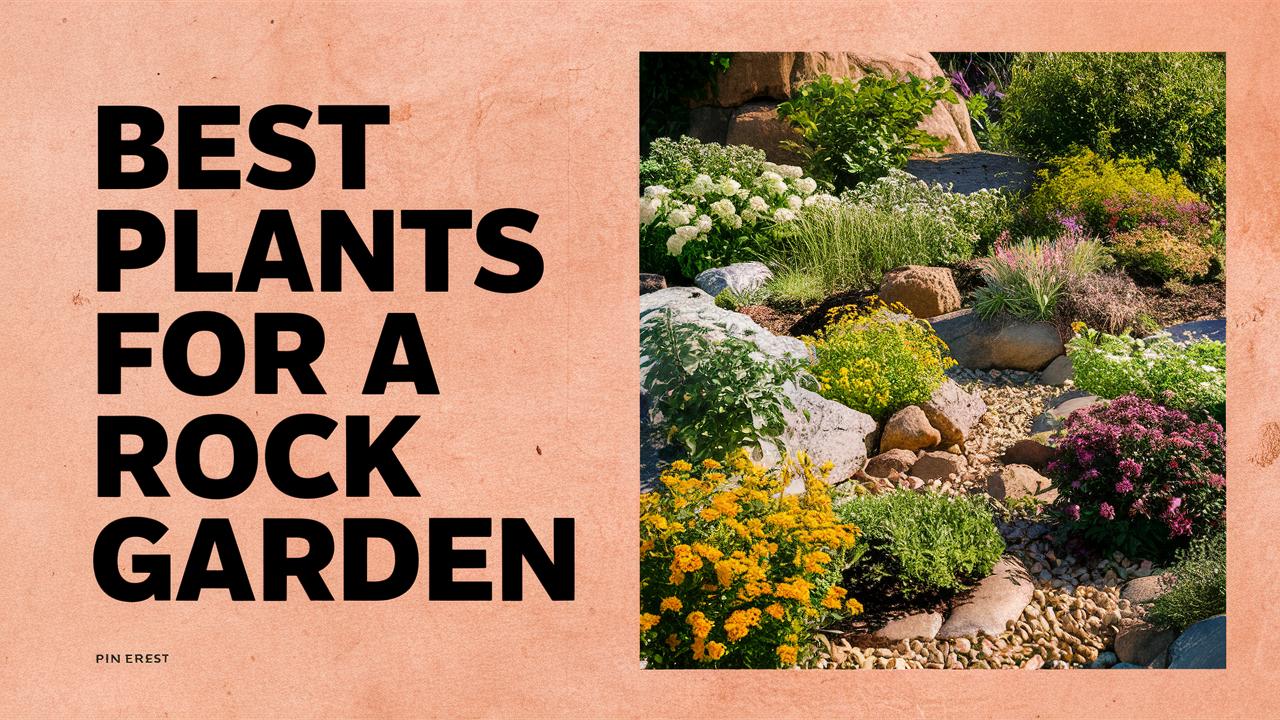In this guide, we’ll explore the best plants that will enhance any rock garden, showcasing their unique characteristics and how they contribute to the overall aesthetic.
Yellow Alyssum
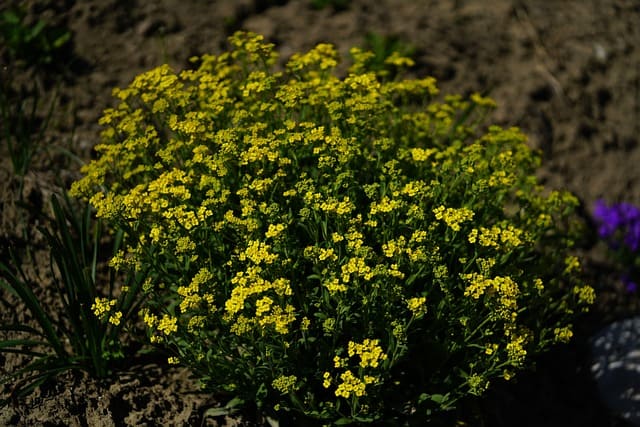
Yellow Alyssum is a delightful perennial that brings a burst of sunshine to any rock garden. With its cheerful yellow blooms, this plant complements rocky outcrops beautifully. It thrives in well-draining soil and full sun, making it perfect for sunny spots. Moreover, it not only attracts pollinators like bees and butterflies but also spreads out to fill gaps, creating a lush carpet effect. Its resilience against drought conditions allows for carefree gardening.
Ice Plant

Ice Plant (Delosperma) is known for its striking, succulent leaves and spectacular flowers that bloom from spring to fall. The vibrant pink, yellow, or purple flowers open wide during sunny days, adding a splash of color to rocky terrains. This succulent plant is drought-tolerant and thrives in sunny, well-drained areas. Its creeping nature makes it a great ground cover, effectively softening the harshness of stones while providing a unique texture that contrasts with the rocky landscape.
Angelina Stonecrop

Angelina Stonecrop (Sedum rupestre ‘Angelina’) is a popular choice in rock gardens due to its striking golden-yellow foliage that can turn a brilliant orange in cooler weather. This low-growing succulent thrives in poor soils, making it a perfect candidate for rocky locales. Its spread of trailing stems adds a whimsical touch to the landscape. Easy to maintain and drought-tolerant, Angelina Stonecrop works well in combinations with other succulents, adding bright colors to an otherwise monochromatic rock garden palette.
Dragon’s Blood Stonecrop
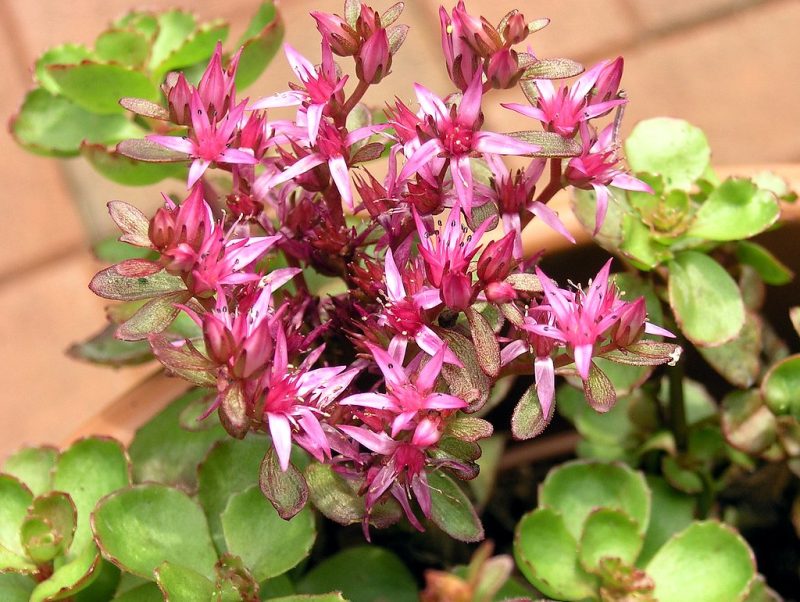
The Dragon’s Blood Stonecrop (Sedum spurium ‘Dragon’s Blood’) is yet another captivating succulent variety. Characterized by its rich red foliage that intensifies in the summer, this plant produces small, star-shaped flowers that bloom in vibrant hues. This low-maintenance plant thrives in well-drained soil and full sun, creating a dense mat that suppresses weeds, making it an excellent choice for those looking to maintain an effortless rock garden. Its unique coloration and structural growth ensure it remains a focal point throughout the seasons.
Hens and Chicks (Sempervivum tectorum)
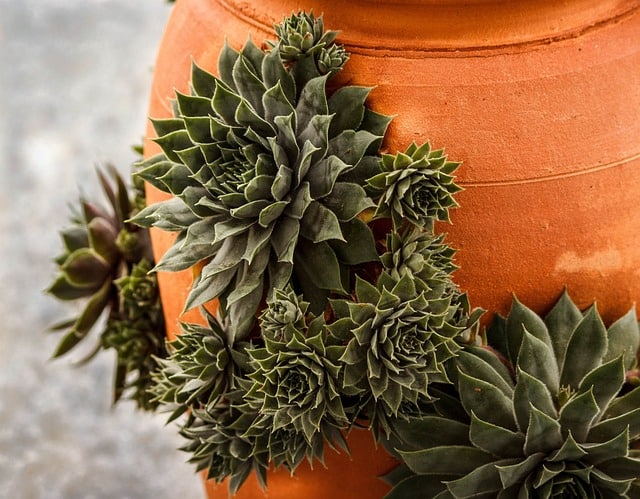
Hens and Chicks, known scientifically as Sempervivum tectorum, are classic rock garden plants. These resilient succulents form rosettes of fleshy leaves that can vary in color from green to purple. They thrive in dry, well-drained soil and are incredibly adaptable to different growing conditions. The name “hens and chicks” comes from the way the mother plant, or “hen,” produces offsets, or “chicks,” that can be propagated easily. Their ability to withstand harsh conditions makes them indispensable in rock gardens, where they provide both visual interest and structural integrity.
Creeping Thyme

Creeping Thyme (Thymus serpyllum) is a fragrant perennial herb that excels as ground cover in rock gardens. Its tiny purple or pink flowers attract pollinators, and its aromatic foliage can be used in the kitchen. This drought-resistant plant thrives in full sun and poor, rocky soils. It grows low to the ground, making it an ideal choice to fill spaces between stones. Its ability to withstand foot traffic also makes it a fantastic option for pathways in rock gardens, providing both utility and beauty.
Blue Fescue Grass

Blue Fescue Grass (Festuca glauca) offers a textural contrast to the hard surfaces of a rock garden. This ornamental grass features fine, blue-green blades that create a striking visual impact. It prefers well-drained soil and full sun, providing an upright growth habit that enhances the vertical elements of a rock garden. It’s a great filler plant that pairs beautifully with both succulents and flowering plants. Its clumping nature also adds structure to the garden layout, making it a versatile option for various settings.
Snow-in-Summer
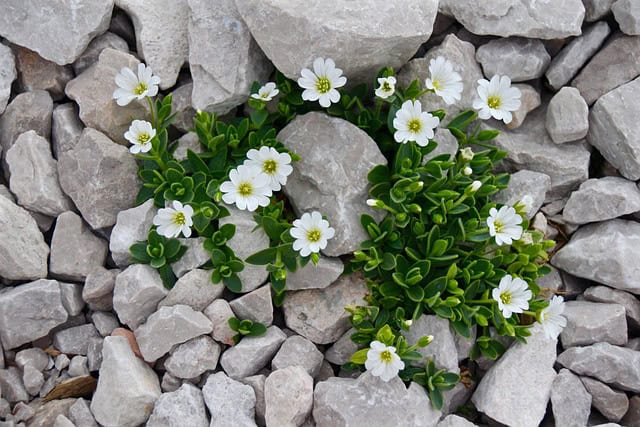
Snow-in-Summer (Cerastium tomentosum) is a low-growing perennial known for its silvery foliage and white flowers that bloom in profusion during late spring and early summer. This hardy plant flourishes in rocky, dry soils and is often used as a ground cover due to its sprawling growth habit. The delicate flowers create a stunning contrast against the gray-green leaves, bringing a sense of brightness and lightness to the rock garden. Additionally, its drought resistance makes it an excellent choice for minimal upkeep.
Candytuft
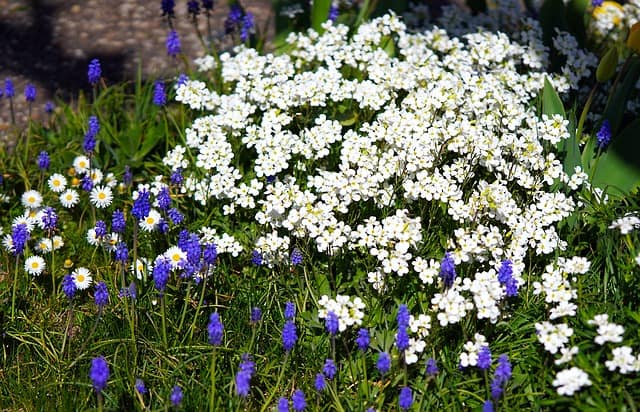
Candytuft (Iberis sempervirens) is another charming perennial suitable for rock gardens. Its cheerful clusters of white flowers stand out against its evergreen foliage, providing year-round interest. This plant thrives in well-drained soils and full sun, making it perfect for rocky outcrops. Its compact, mounding growth habit fits well in small spaces, while its ability to bloom profusely in spring makes it an attractive choice for adding color early in the season.
Ajuga
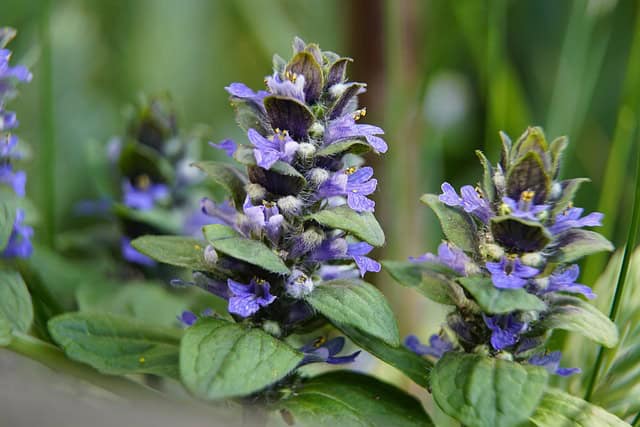
Ajuga, commonly known as bugleweed, is a versatile ground cover with attractive foliage that ranges from deep green to purple. It produces spikes of blue flowers in the spring, which add to its appeal. Ajuga thrives in various soil types but prefers well-drained areas, making it a resilient choice for rock gardens. Its ability to tolerate light foot traffic allows it to transition smoothly between garden paths and planted areas. Ajuga is also a great plant for attracting pollinators, contributing to the biodiversity of your garden.
Creeping Phlox
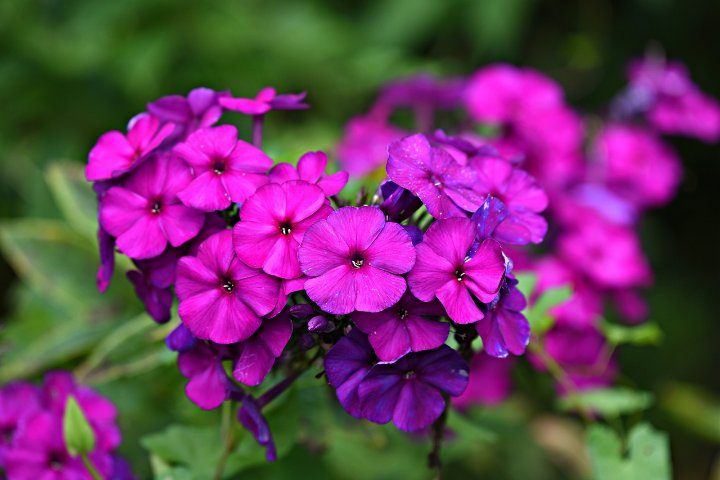
Creeping Phlox (Phlox subulata) is a stunning ground cover that blooms with vibrant flowers in shades of purple, pink, and white in spring. Its lush green foliage provides an excellent contrast to the colorful blooms, and the plant spreads quickly, filling in gaps between stones beautifully. Creeping phlox thrives in sunny, well-draining soil, making it an essential component in any rock garden. Its ability to produce copious flowers helps brighten the garden and attracts bees and butterflies, enriching the ecosystem.
Pasque Flower

The delicate Pasque Flower (Pulsatilla vulgaris) adds a touch of early spring beauty to rock gardens. Known for its unique, bell-shaped purple flowers and fern-like foliage, its blooms appear before most other plants, making it a cherished first sign of spring. This perennial prefers well-drained soil and full sun to partial shade, thriving on slopes and rocky terrain. In addition to its beauty, the pasque flower is known for its resilience, making it a stunning and hardy choice for rock formations.
Reticulated Iris
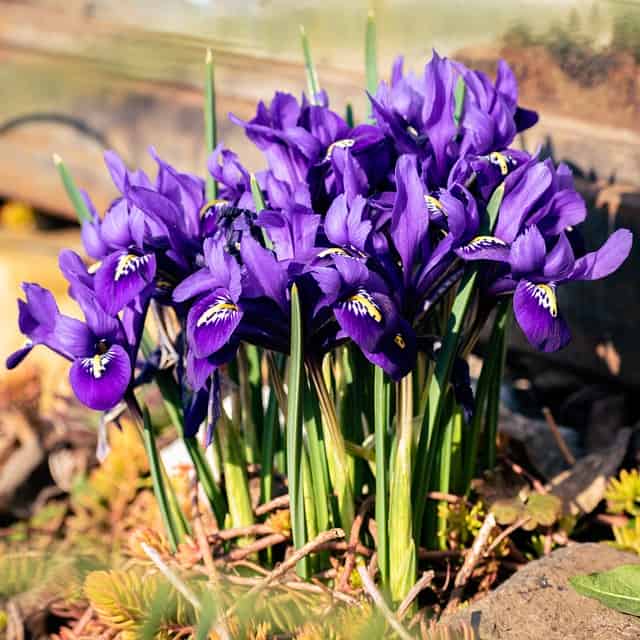
Reticulated Iris (Iris reticulata) is an early-blooming, dwarf iris that captivates with its stunning blue or purple flowers speckled with intricate patterns. This species is perfect for the rock garden due to its compact growth habit and preference for well-drained, sandy soil. Planting these irises among stones allows for a naturalistic look that is both sophisticated and charming. They add pops of color to the garden in early spring, while their grass-like foliage complements the rugged textures of a rock garden.
Wood Spurge
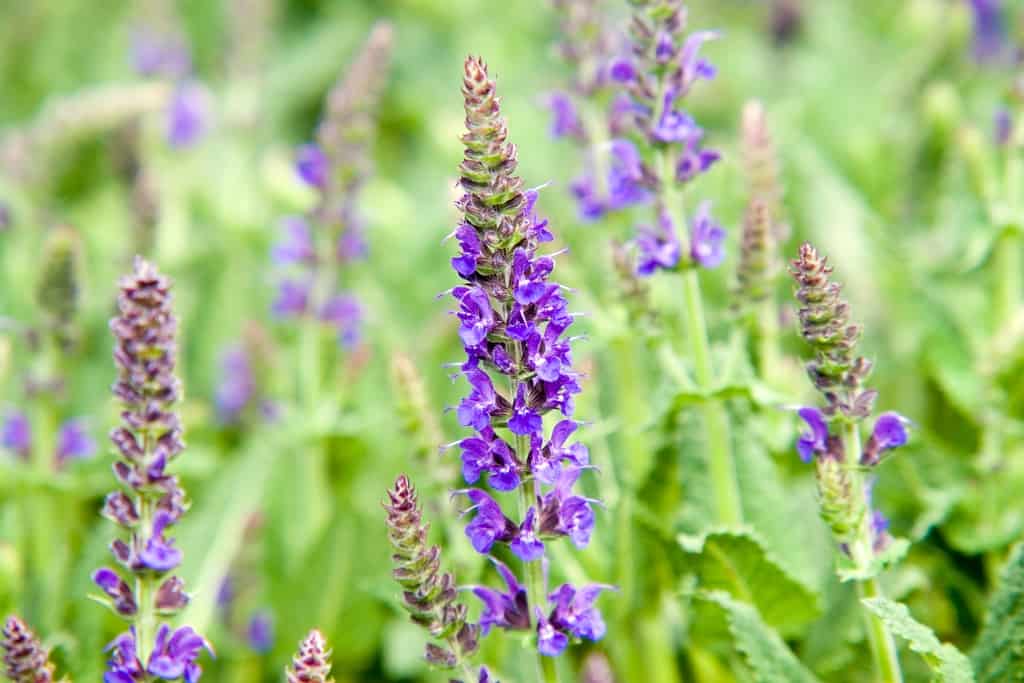
Wood Spurge (Euphorbia amygdaloides) is a hardy perennial that features glossy green foliage with bright yellow-green bracts that appear in spring. This evergreen plant thrives in well-drained soil and can tolerate shade, making it a versatile addition to rock gardens that experience varying light conditions. Its unique form adds architectural interest, while its drought resistance ensures it remains low maintenance. The wood spurge is excellent for filling in areas where other plants may struggle, effectively adding volume to the landscape.
Moonbeam Coreopsis
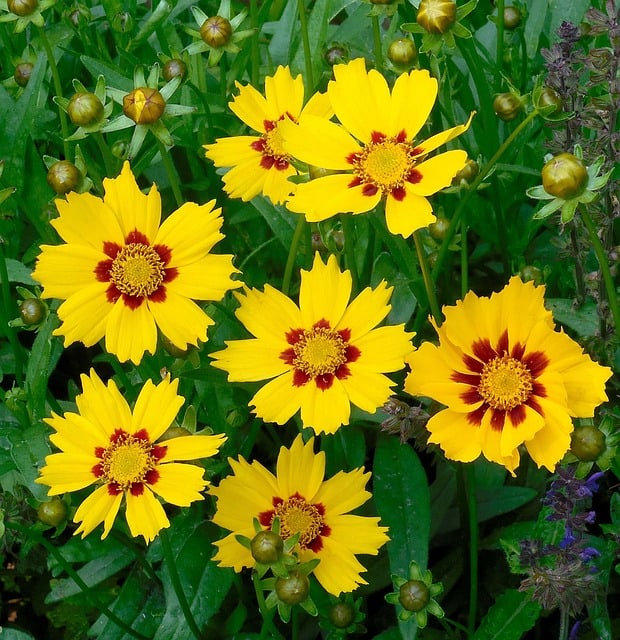
Moonbeam Coreopsis (Coreopsis verticillata) offers golden-yellow flowers that bloom from early summer to fall, providing continuous color to the rock garden. Its fine, feathery foliage creates a soft-textured contrast against rocky surfaces. This hardy perennial grows best in full sun and well-drained soil, attracting bees and butterflies to its blooms. Its compact form and long flowering season make it an ideal plant to include in borders and grouped plantings within a rock garden.
Lavender

Lavender (Lavandula) is a beloved addition to rock gardens for its fragrant purple flowers and aromatic foliage. This drought-tolerant perennial thrives in full sun and well-drained soil, making it an ideal candidate for rocky slopes. Besides being visually stunning, lavender attracts pollinators and is a fantastic choice for lower maintenance gardens. Its height and texture provide contrast with low-lying plants, enhancing both the sensory and aesthetic experience of the rock garden.
Yarrow

Yarrow (Achillea millefolium) is a hardy perennial known for its feathery foliage and clusters of tiny flowers that bloom in various colors, including yellow, white, pink, and red. Yarrow is exceptionally drought-tolerant and thrives in low nutrient, well-drained soil, making it a perfect fit for rock gardens. Its ability to attract butterflies and other pollinators is a significant bonus, adding liveliness to the garden. With a graceful, open form and strong resilience, yarrow offers both beauty and usefulness in naturalistic designs.
Autumn Joy Sedum

Autumn Joy Sedum (Sedum ‘Autumn Joy’) is a charming succulent that provides seasonal interest with its stunning pink flowers that deepen to a rich red in the fall. This perennial thrives in well-drained soil and full sun, making it ideal for rock gardens. Its ability to attract pollinators turns your garden into a vibrant habitat. The fleshy leaves are also water-efficient, ensuring low maintenance as they thrive even in drought conditions. The upright habit and bright color variations make it a perfect centerpiece in mixed plantings.
Spiked Speedwell
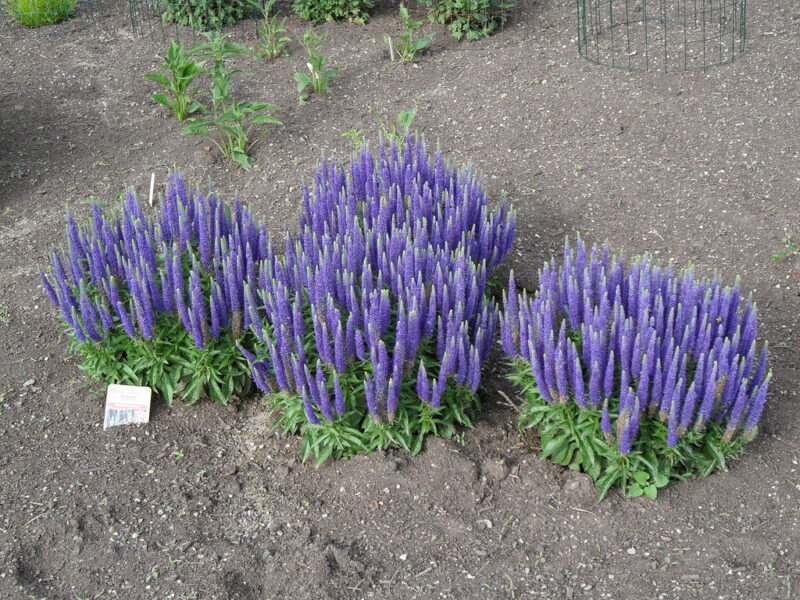
Spiked Speedwell (Veronica spicata) is a perennial that produces tall spikes of blue, purple, or white flowers during the summer. This sturdy plant thrives in well-drained soil and full sun, contributing vertical interest to the rock garden. Its dense foliage creates an attractive backdrop for lower-growing plants, while its resilient nature allows it to withstand varying weather conditions. Speedwell’s long bloom time and ability to attract pollinators enhance the natural beauty of the garden, adding color and life throughout the summer months.
Columbine
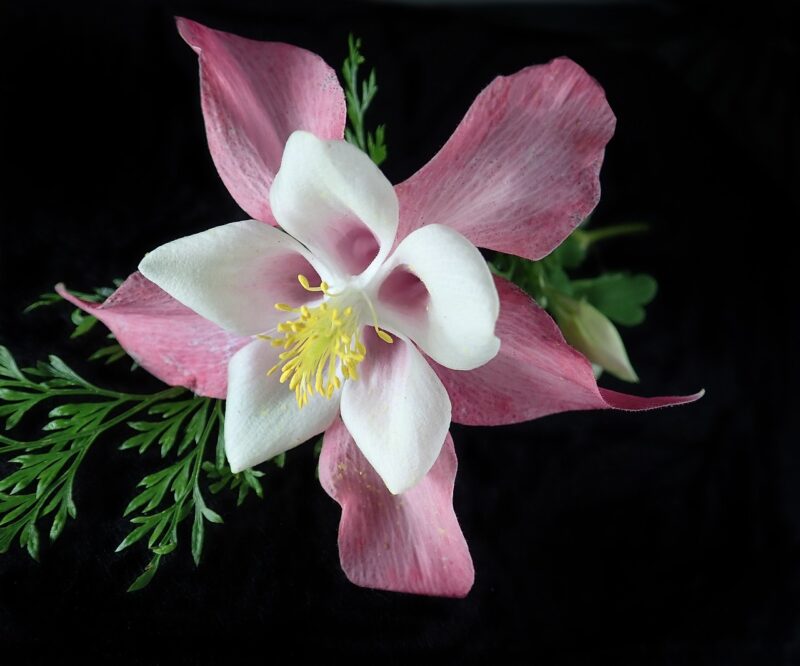
Columbine (Aquilegia) is a charming perennial known for its unique, nodding flowers that come in a range of colors, including blue, purple, yellow, and red. These plants thrive in well-drained soil and can tolerate some shade, making them adaptable for various rock garden designs. The delicate, lacy foliage attracts hummingbirds and other beneficial pollinators, enriching your garden’s ecosystem. Columbine brings a whimsical touch to the rock garden, offering both visual interest and attracting wildlife.
Coneflower
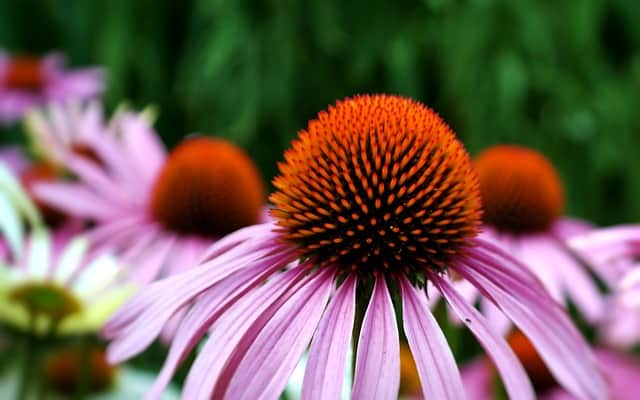
Coneflower (Echinacea) is a hardy perennial that brings bold color and height to the rock garden. With its daisy-like flowers featuring prominent central cones surrounded by vibrant petals, it blooms throughout summer and into autumn. Coneflowers thrive in well-drained soil and full sun, making them perfect for rocky locations. Their ability to attract pollinators, including bees and butterflies, enhances the dynamism of a rock garden while providing long-lasting beauty.
Purple Fountain Grass
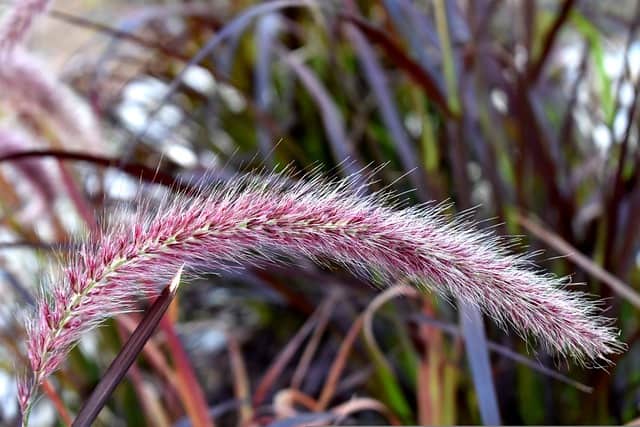
Purple Fountain Grass (Pennisetum setaceum ‘Rubrum’) adds drama to a rock garden with its striking purple-tinged foliage and elegant, flowing flower spikes. This ornamental grass thrives in full sun and well-drained soil, bringing a graceful texture that complements the rugged stones. Its ability to withstand drought conditions makes it low maintenance, ensuring that it continues to perform even in harsher climates. The contrasting shapes and colors of purple fountain grass elevate the overall aesthetic of any garden while creating movement and interest.
Blue Rug Juniper

Blue Rug Juniper (Juniperus horizontalis ‘Wiltonii’) is an evergreen ground cover that thrives in a rock garden setting. Its rich blue-green foliage is a perfect contrast to rocky textures and can spread widely, effectively filling in gaps while anchoring the landscape. This resilient plant is drought-tolerant and requires little maintenance, making it ideal for busy gardeners. Its sprawling habit creates stunning layers in a rock garden, while its aromatic foliage adds sensory appeal.
Shasta Daisy
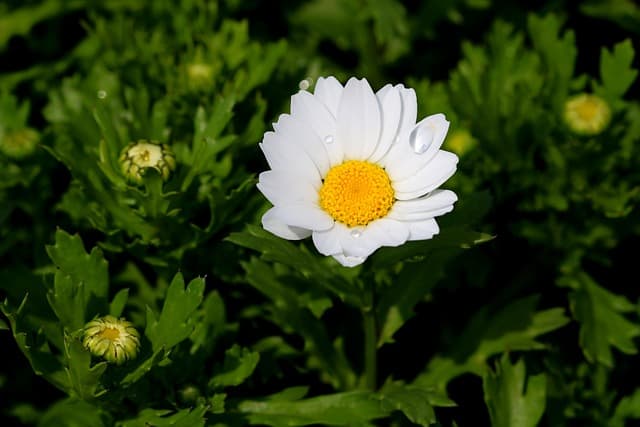
Shasta Daisy (Leucanthemum × superbum) is a classic perennial that embodies the spirit of a sunny rock garden. Known for its cheerful white petals and bright yellow centers, it blooms from late spring to fall, bringing a touch of nostalgia and charm. Shasta daisies thrive in well-drained soil and full sun, making them resilient options for rock gardens. They add height and character, creating a delightful visual display that dazzles throughout the growing season.
Black-Eyed Susan
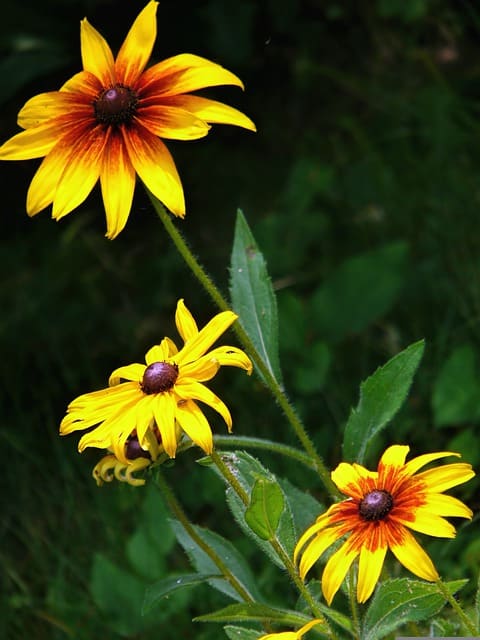
Black-Eyed Susan (Rudbeckia hirta) is a vibrant perennial with bold yellow petals and a dark, cone-shaped center. These cheerful flowers bloom in the summer and continue to brighten the garden into fall. They flourish in well-drained soil and full sun, adding both color and texture to rocky landscapes. Additionally, their capability to attract pollinators contributes to building a lively ecosystem in the rock garden. This hardy perennial is a must-have for gardeners looking to bring life and vibrancy to their outdoor spaces.
Perennial Salvia

Perennial Salvia (Salvia nemorosa) is a robust, flowering perennial known for its tall spikes of blue, purple, or white flowers. It thrives in sunny, well-drained environments and blooms from late spring through summer, providing important nectar for bees and butterflies. Its compact clumping habit allows it to fit beautifully amid rocky outcrops while providing contrast between its upright blooms and the ground-level plants. The aromatic foliage is another bonus, adding another sensory dimension to the rock garden.
Six Hills Giant Catmint

Six Hills Giant Catmint (Nepeta × faassenii) is a perennial herb that adds soft texture and scent to a rock garden. Known for its upright growth and tall spikes of lavender-blue flowers, it thrives in well-drained soil and full sun. Catmint’s aromatic foliage attracts pollinators and can produce blooms from late spring to early fall, creating long-lasting color within the garden. Its ability to spread efficiently makes it a great choice for filling spaces and softening edges in rocky areas, while its deer and rabbit-resistant qualities make it a tough competitor in the landscape.
Russian Sage
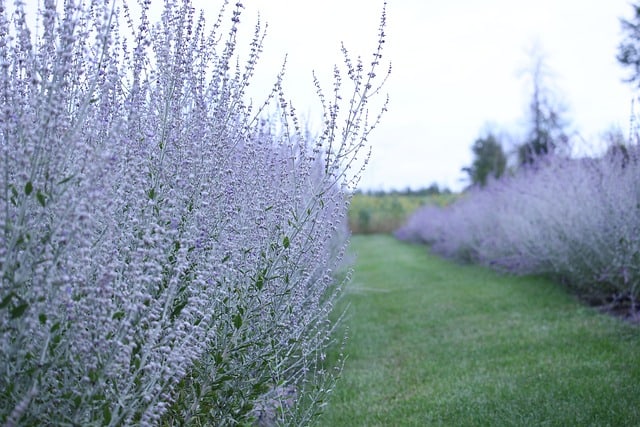
Russian Sage (Perovskia atriplicifolia) delivers a striking presence with its tall, airy spikes of purple flowers and silvery foliage. This perennial thrives in well-drained soil and full sun, making it perfect for hot, dry conditions often found in rock gardens. Its drought tolerance and minimal maintenance needs make it a favorite among gardeners. The delicate, feathery appearance lends itself well to contrasting with harder rocky textures, adding grace and elegance to the garden throughout the summer months.
Mugo Pine
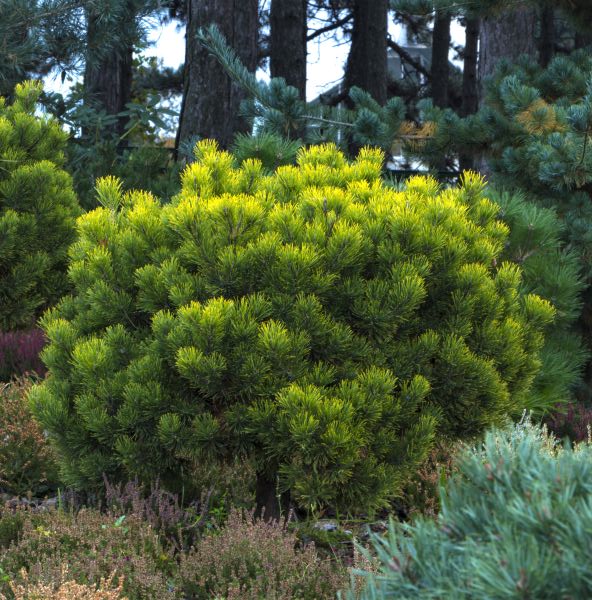
Mugo Pine (Pinus mugo) is a versatile evergreen that adds vertical height and structure to a rock garden. Its dense, bushy foliage provides a year-round backdrop, while its ability to thrive in a variety of soil types and conditions makes it an adaptable choice. Mugo Pine is low-maintenance and drought-resistant, allowing it to remain lush even when rainfall is scarce. Its resilient nature and the soft, forest green needles create a naturalistic feel that enhances the overall design and provides a lovely contrast against other flowering plants.
Rockspray Cotoneaster

Rockspray Cotoneaster (Cotoneaster horizontalis) is a delightful ground cover that brings a sprawling effect to rock gardens. Its attractive, small, oval leaves turn vibrant shades in the fall, while small pink flowers bloom in spring, followed by bright red berries later in the season. This plant thrives in well-drained soil and sunny locations, making it an excellent companion for stone structures. Its ability to create undulating shapes against rocky textures adds depth to the landscape while providing important forage for wildlife.
Lamb’s Ear

Lamb’s Ear (Stachys byzantina) boasts soft, velvety leaves that create an inviting and tactile experience in the rock garden. This perennial thrives in well-drained soil and full sun, spreading efficiently to form dense mats that soften the hard edges of stones. Its muted green leaves can also serve as an attractive backdrop to the colorful flowers that appear in summer. Perfect for creating a textural contrast, Lamb’s Ear is a wonderful choice for hands-on gardeners and children alike who enjoy its fluffy, fuzzy touch.
Maiden Grass
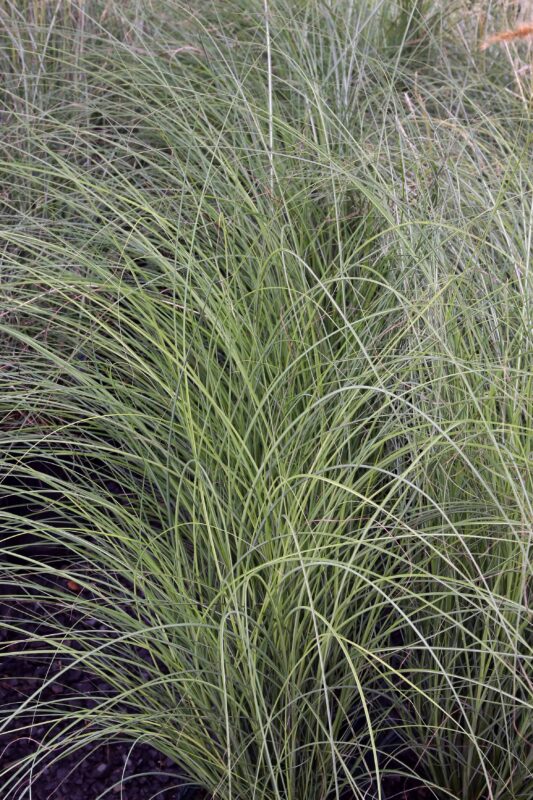
Maiden Grass (Miscanthus sinensis) offers a graceful presence in rock gardens, with its tall, arching blades and feathery flower plumes. This ornamental grass thrives in full sun and well-drained soils while providing visual drama and movement to the landscape. Its ability to withstand drought makes it a practical choice, and it enhances the overall aesthetic with its waves of foliage swaying in the breeze. Maiden Grass’s height can create beautiful layers within the rock garden, ensuring it stands out amidst lower-growing plants.
Rugosa Rose
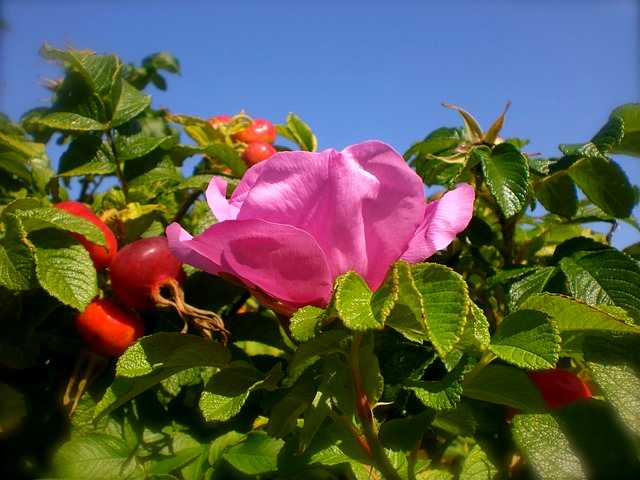
Finally, the Rugosa Rose (Rosa rugosa) is a resilient and fragrant addition to rock gardens. Known for its wild, informal beauty and ability to thrive in poor, sandy soils, this plant produces large, fragrant blooms in a variety of colors throughout the summer. The attractive, glossy leaves turn vibrant shades in the fall, adding seasonal interest. Rugosa Roses provide structure and a natural form, enhancing the overall rustic appeal of the rock garden while attracting pollinators and providing a nostalgic charm reminiscent of old-world gardens.


